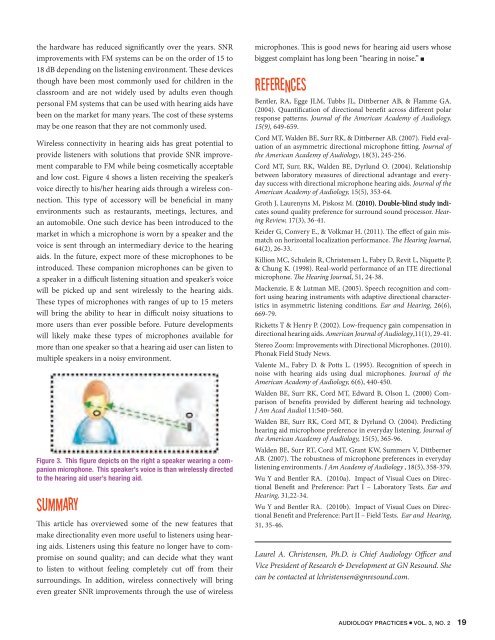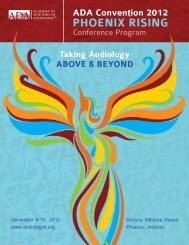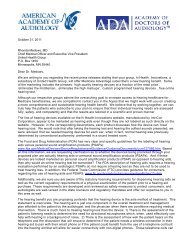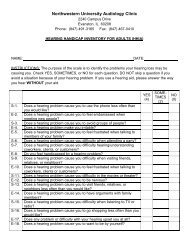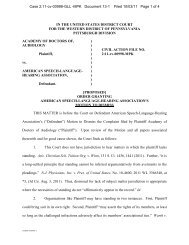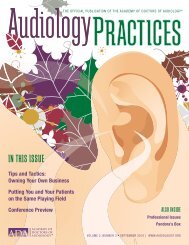IN THIS ISSUE - Academy of Dispensing Audiologists
IN THIS ISSUE - Academy of Dispensing Audiologists
IN THIS ISSUE - Academy of Dispensing Audiologists
Create successful ePaper yourself
Turn your PDF publications into a flip-book with our unique Google optimized e-Paper software.
the hardware has reduced significantly over the years. SNR<br />
improvements with FM systems can be on the order <strong>of</strong> 15 to<br />
18 dB depending on the listening environment. These devices<br />
though have been most commonly used for children in the<br />
classroom and are not widely used by adults even though<br />
personal FM systems that can be used with hearing aids have<br />
been on the market for many years. The cost <strong>of</strong> these systems<br />
may be one reason that they are not commonly used.<br />
Wireless connectivity in hearing aids has great potential to<br />
provide listeners with solutions that provide SNR improvement<br />
comparable to FM while being cosmetically acceptable<br />
and low cost. Figure 4 shows a listen receiving the speaker’s<br />
voice directly to his/her hearing aids through a wireless connection.<br />
This type <strong>of</strong> accessory will be beneficial in many<br />
environments such as restaurants, meetings, lectures, and<br />
an automobile. One such device has been introduced to the<br />
market in which a microphone is worn by a speaker and the<br />
voice is sent through an intermediary device to the hearing<br />
aids. In the future, expect more <strong>of</strong> these microphones to be<br />
introduced. These companion microphones can be given to<br />
a speaker in a difficult listening situation and speaker’s voice<br />
will be picked up and sent wirelessly to the hearing aids.<br />
These types <strong>of</strong> microphones with ranges <strong>of</strong> up to 15 meters<br />
will bring the ability to hear in difficult noisy situations to<br />
more users than ever possible before. Future developments<br />
will likely make these types <strong>of</strong> microphones available for<br />
more than one speaker so that a hearing aid user can listen to<br />
multiple speakers in a noisy environment.<br />
Figure 3. This figure depicts on the right a speaker wearing a companion<br />
microphone. This speaker’s voice is than wirelessly directed<br />
to the hearing aid user’s hearing aid.<br />
Summary<br />
This article has overviewed some <strong>of</strong> the new features that<br />
make directionality even more useful to listeners using hearing<br />
aids. Listeners using this feature no longer have to compromise<br />
on sound quality; and can decide what they want<br />
to listen to without feeling completely cut <strong>of</strong>f from their<br />
surroundings. In addition, wireless connectively will bring<br />
even greater SNR improvements through the use <strong>of</strong> wireless<br />
microphones. This is good news for hearing aid users whose<br />
biggest complaint has long been “hearing in noise.” n<br />
References<br />
Bentler, RA, Egge JLM, Tubbs JL, Dittberner AB, & Flamme GA.<br />
(2004). Quantification <strong>of</strong> directional benefit across different polar<br />
response patterns. Journal <strong>of</strong> the American <strong>Academy</strong> <strong>of</strong> Audiology,<br />
15(9), 649-659.<br />
Cord MT, Walden BE, Surr RK, & Dittberner AB. (2007). Field evaluation<br />
<strong>of</strong> an asymmetric directional microphone fitting. Journal <strong>of</strong><br />
the American <strong>Academy</strong> <strong>of</strong> Audiology, 18(3), 245-256.<br />
Cord MT, Surr, RK, Walden BE, Dyrlund O. (2004). Relationship<br />
between laboratory measures <strong>of</strong> directional advantage and everyday<br />
success with directional microphone hearing aids. Journal <strong>of</strong> the<br />
American <strong>Academy</strong> <strong>of</strong> Audiology, 15(5), 353-64.<br />
Groth J, Laurenyns M, Piskosz M. (2010). Double-blind study indiindicates sound quality preference for surround sound processor. Hearing<br />
Review, 17(3), 36-41.<br />
Keider G, Convery E., & Volkmar H. (2011). The effect <strong>of</strong> gain mismatch<br />
on horizontal localization performance. The Hearing Journal,<br />
64(2), 26-33.<br />
Killion MC, Schulein R, Christensen L, Fabry D, Revit L, Niquette P,<br />
& Chung K. (1998). Real-world performance <strong>of</strong> an ITE directional<br />
microphone. The Hearing Journal, 51, 24-38.<br />
Mackenzie, E & Lutman ME. (2005). Speech recognition and comfort<br />
using hearing instruments with adaptive directional characteristics<br />
in asymmetric listening conditions. Ear and Hearing, 26(6),<br />
669-79.<br />
Ricketts T & Henry P. (2002). Low-frequency gain compensation in<br />
directional hearing aids. American Journal <strong>of</strong> Audiology,11(1), 29-41.<br />
Stereo Zoom: Improvements with Directional Microphones. (2010).<br />
Phonak Field Study News.<br />
Valente M., Fabry D. & Potts L. (1995). Recognition <strong>of</strong> speech in<br />
noise with hearing aids using dual microphones. Journal <strong>of</strong> the<br />
American <strong>Academy</strong> <strong>of</strong> Audiology, 6(6), 440-450.<br />
Walden BE, Surr RK, Cord MT, Edward B, Olson L. (2000) Comparison<br />
<strong>of</strong> benefits provided by different hearing aid technology.<br />
J Am Acad Audiol 11:540–560.<br />
Walden BE, Surr RK, Cord MT, & Dyrlund O. (2004). Predicting<br />
hearing aid microphone preference in everyday listening. Journal <strong>of</strong><br />
the American <strong>Academy</strong> <strong>of</strong> Audiology, 15(5), 365-96.<br />
Walden BE, Surr RT, Cord MT, Grant KW, Summers V, Dittberner<br />
AB. (2007). The robustness <strong>of</strong> microphone preferences in everyday<br />
listening environments. J Am <strong>Academy</strong> <strong>of</strong> Audiology , 18(5), 358-379.<br />
Wu Y and Bentler RA. (2010a). Impact <strong>of</strong> Visual Cues on Directional<br />
Benefit and Preference: Part I – Laboratory Tests. Ear and<br />
Hearing, 31,22-34.<br />
Wu Y and Bentler RA. (2010b). Impact <strong>of</strong> Visual Cues on Directional<br />
Benefit and Preference: Part II – Field Tests. Ear and Hearing,<br />
31, 35-46.<br />
Laurel A. Christensen, Ph.D. is Chief Audiology Officer and<br />
Vice President <strong>of</strong> Research & Development at GN Resound. She<br />
can be contacted at lchristensen@gnresound.com.<br />
AUDIOLOGY PRACTICES n VOL. 3, NO. 2 19


